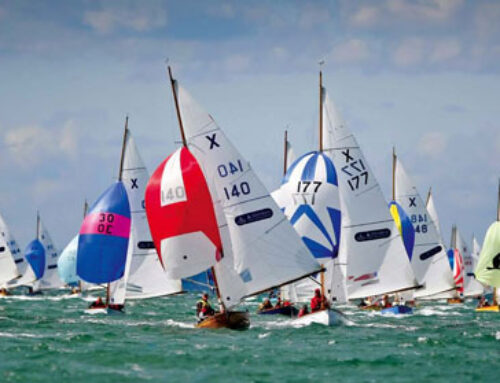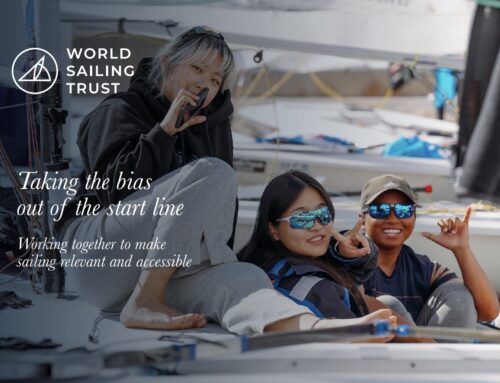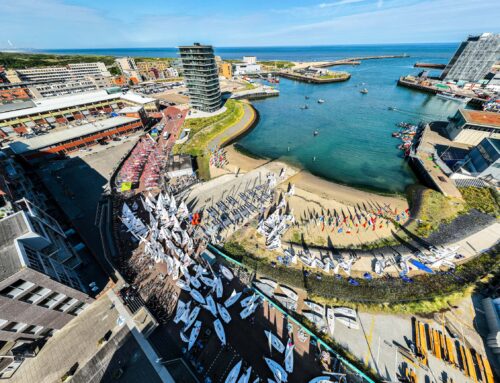Sailing is becoming more diverse and there is, on the surface at least, a palpable change and importantly a realisation at the highest level of the sport that to grow, develop and continue to be relevant, we need to be more inclusive, diversify more and increase participation across all areas. But for those looking to make a serious career in sailing there are still road blocks, and the thorny issue of salaries and the gender pay gap has again raised its head in recent weeks. In the following article, we look generically at the pay gap at the highest level of our sport, and reflect on how this is firmly entrenched in cultural attitudes towards women in sailing.
Dee Caffari, Chair
Editorial
While we continue to make great strides forward in achieving greater equity in our sport, there continue to be road blocks along the way.
This summer, the news focus in women’s sport was around greater pay equity between male and female athletes. This was highlighted with the strike by Spanish female football players who were asking for a salary pay rise to €25,000 per annum for the upcoming season, and a €30,000 salary for the 2024 season. Given the advertised salaries of their male counterparts*, the question could be asked, why are the women only asking for a €6000 pay increase when the men earn substantially more than that in a single week?
From 2007 onwards in tennis, women have been paid the same as men, at ATP Tour events like Wimbledon and the US Open, and in August this year the England and Wales Cricket Board (ECB) announced their decision to have equal match fees for the women’s and men’s teams.
So how does sailing compare?
In the 2019 Women in Sailing Strategic Review, over 88% of female respondents stated that they received no financial support for their sailing. Of the 12% that did receive financial support, only 17% of those received a day rate or annual salary, the remainder received their ‘payment’ as benefits in kind in the form of travel, accommodation, and subsistence to attend events.
Four years on from the Strategic Review, it does not appear that the landscape is very different, and sailing is again falling behind other sports. Despite forward movement in greater inclusion across some of our leading events, the issue of pay is not moving forward at the same rate.
Olympian and world champion sailor Jo Aleh, who is also the Athlete representative on World Sailing’s Board, confirms: “I am still pleasantly surprised when I do get paid for sailing, as it has not been the norm throughout my experiences. While there are national sports training grants accessible for my Olympic sailing, SailGP was the first pro sailing I have done where I have been paid as a full member of a team, other than that, the norm for me has always been expenses only. And that applies to most of the female sailors I know. The quote “You should be happy to do this for the experience” has become less and less digestible over time.”
There is no overarching mandate in the sport to support ‘equal pay, equal play’, so the pay conditions are down to individual teams and events, and as such there is a huge discrepancy in salary levels.
Worryingly these salary levels fall, the majority of the time, well below the national living wage in respective countries. So, the problem, if we are to grow participation in the sport across all areas, be more inclusive and open to all areas of society, at present, is you cannot take part in some of our leading events unless you have a second income or you are independently wealthy.
A significant gender pay gap will discourage women from pursuing a professional career in sailing, especially if they perceive that their earning potential, compared to their male counterparts is limited. It is natural that they may be less inclined to invest time and resources in pursuing a career in our sport resulting in a talent pool that is smaller and less competitive. And for those that do enter the world of sailing, the gender pay gap can affect their decision to stay in the sport. The lack of financial rewards may make it difficult for female athletes to sustain a long-term career, leading to early retirement or a shift to other professions.
This focus on pay gap has again become apparent with the Women’s and Youth America’s Cup. The America’s Cup, arguably the leading event in our sport after the Olympics, has embraced inclusivity and created an ‘electrifying pathway to the America’s Cup…’ with a clear ambition to attract the next generation of foiling superstars to a platform to showcase their talents. A total of twelve teams have entered the event, including the six declared America’s Cup teams.
With the selection procedure for the Women and Youth reaching its concluding stages, the thorny issue of salaries has raised its head, and it appears that the pay scales across the six declared AC teams are vastly different, with two teams paying the professional and experienced sailors in their Women’s teams well below the national living wage of their respective countries.
So, the ‘electrifying pathway’ comes at a huge financial burden to many of the experienced women taking part in the event, and the training period beforehand.
With average daily rates in Europe of between €350-500/day, the current offerings by some of the teams are inadequate and would require having a second income to be able to continue paying for simple things like rent, food, and fuel bills as well as childcare. As an example, and not unlike that of the Spanish female football players, the salaries on offer from some teams to their experienced professional W&YAC female sailors for the five-month training and event period, is less that the average monthly salary of a male America’s Cup** sailor.
But this is not just an America’s Cup story, the issue of paying female sailors is something that is endemic across most of our leading events. However, there are some notable exceptions and some teams (including some in the AC) are starting to lead the way.
So, for our sport to continue to promote greater gender equality and encourage a broader participation in sailing, efforts need to be made to address the gender pay gap. Closing the gender pay gap will contribute to a more inclusive and equitable sports culture, fostering increased interest and involvement from individuals of all genders. However, all of this requires a combination of societal changes, policy interventions, and shifts in cultural attitudes towards women in sailing, along with internal reforms within our sports teams and organisations.
* The average player in the Spanish premiership gets upwards of €35,000 per week. [Source: www.capology.com]
** The average monthly salary for an America’s Cup sailor starts at €8000/month






